Qualifying prospects is a critical step in the sales process. It keeps you from spending time on opportunities that are unlikely to convert. And helps you determine where you should prioritize your efforts.
It’s easier said than done, of course. So how do you qualify leads? How do you determine if a prospect is a good fit for your products or services?
Using a sales qualification framework like BANT can help.
In this guide, we’ll describe the BANT framework, including what it is and how to determine if it’s right for your team. We’ll also clarify how you can implement this framework and provide a list of sales qualifying questions that you can ask.
What is BANT?
BANT is a sales qualification framework that was originally developed by IBM. It helps sales teams qualify prospects and determine if they have a high chance of converting.
BANT is an acronym for:
- Budget: What is the prospect’s budget?
- Authority: Do they have decision-making authority?
- Needs: What are their business needs?
- Timeline: When are they looking to make a purchase?
A prospect is considered viable if they meet at least three of the four criteria. However, if a prospect doesn’t meet the criteria, the sales rep can follow up later.
What makes the BANT sales qualification framework unique?
There are only so many hours in the day, which is why you want your sales team to focus on the most promising opportunities. This will help increase win rates and generate more sales.
Here’s how the different components of the BANT framework help with sales qualification.
Budget: Can they afford your solution?
Money is an important factor in any purchasing decision. If something is outside your budget, you have to either forego it altogether or consider other options. The same is true for your prospects.
A prospect needs to have the available budget to be considered a buyer. If they can’t afford your solution, they’re likely not a good fit. By talking about pricing early on, a sales rep can determine whether to move on from a lead.
But don’t jump the gun too soon.
A prospect may not have the budget now, but their circumstances could change. Likewise, if you can justify the value of your solution, you can overcome pricing objections and convince your prospects to buy.
Authority: Are they a decision-maker?
Purchasing decisions often involve multiple stakeholders — some are gatekeepers who are simply passing along information, while others have the final say.
Learning more about your prospects can help you determine if they have the authority to proceed with the next steps or if you need to get others involved.
Even if a prospect isn’t a decision-maker, they likely have some influence within the organization, so don’t make them feel undervalued. Build trust with your point of contact, and you can even turn them into advocates for your company.
Needs: Does your solution address their needs?
The next step in the BANT framework is to understand your prospects’ needs. What challenges are they facing, and does your solution solve them?
If not, you’d disqualify a prospect and move on. It’s better to prioritize those who have an actual need for your solution because they’re more likely to derive value from it and turn into lifelong customers.
Timeline: When do they plan to make a purchase?
The last BANT component is the timeline.
Prospects keen on making a purchase soon, have a higher sense of urgency. By prioritizing these leads, you can speed up the sales cycle and close more deals.
Is the BANT sales qualification framework right for your team?
BANT is a popular qualification framework, but what works for one company may not work for another. Weighing its pros and cons can help you determine if it’s a good fit for your sales team.

Let’s start with the benefits of the BANT framework.
Pros of using BANT
One of the primary benefits of the BANT framework is that you can apply it to different buyer personas. You can easily modify the questions and relate to the person you’re speaking to.
BANT is also a flexible qualification framework. Whether you’re the head of sales for a Software-as-a-Service (SaaS) startup or an enterprise, you can adapt the framework and continue to refine it over time.
Finally, following the BANT framework helps keep your team on the same page. This ensures your team follows the same standards when qualifying opportunities.
Cons of using BANT
BANT was created in the 1960s, so it’s not exactly modern. While the fundamentals are still intact, this decades-old framework falls short in some areas.
Take the budget criteria, for instance. Disqualifying a prospect because they’re not ready to buy soon could cause you to lose the deal if their circumstances change (e.g., they receive funding).
Another drawback is that BANT is more seller-centric. Sales reps aren’t building relationships or providing value. They’re trying to determine whether a lead is worth pursuing, but this can be off-putting depending on how the questions are asked.
Whether you choose to implement the BANT framework to qualify prospects is up to you. But it does offer a proven method for identifying quality prospects.
How to use the BANT framework to qualify prospects (with questions)
Follow the steps below to implement the BANT sales qualification framework. We’ve also included sales qualification questions you should ask to quickly identify which prospects meet your criteria.
1. Create an Ideal Customer Profile (ICP)
Not every prospect is the perfect fit for your company. So how can you ensure that your reps are spending time on opportunities that are more likely to close?
This is where an Ideal Customer Profile comes in — a description of the type of company that can benefit the most from your products or services. It aligns your sales and marketing teams and ensures that you’re targeting the right prospects.

The first step when creating an ICP is to identify your best customers. Look through your CRM, sales intelligence platform, or whatever else you use to gather this data. You’re looking for high-value customers who have been with your company a long time.
Look at the list you created and identify common attributes. Consider the following attributes to narrow down your ideal customer:
- Industry/vertical
- Company size
- Annual revenue
- Employee count
- Geographic location
- Key challenges
- Technology stack
This list is not exhaustive by any means, but it does offer a great starting point. If a prospect doesn’t fit your ICP, consider disqualifying them.
2. Determine your prospect’s budget
The first BANT criterion is budget.
Understanding how much your prospects can spend is key to qualifying them. It also helps you properly scope a project and manage expectations early on.
However, discussing pricing can be tricky. Asking prospects what their budget is right away can scare them away because it comes off as aggressive. However, the longer you wait to discuss pricing, your chances of closing the deal reduce significantly.
So when should you ask your prospects about their budget? Data from our revenue intelligence platform shows that win rates are 10% higher when pricing is discussed on the first call.
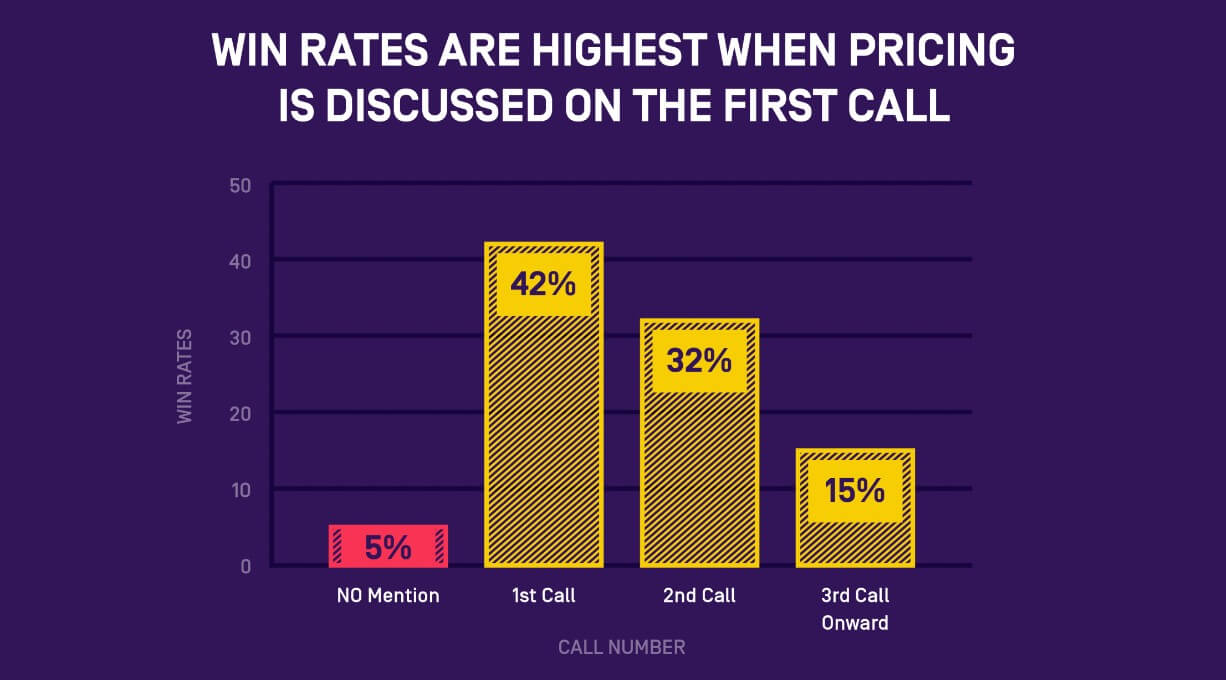
But timing matters here.
You don’t want to start a sales call with a budget question and push your prospects away before you have a chance to build a relationship with them.
We found that the top reps discuss pricing about 38 to 46 minutes into a call, while average reps bring up pricing much earlier.
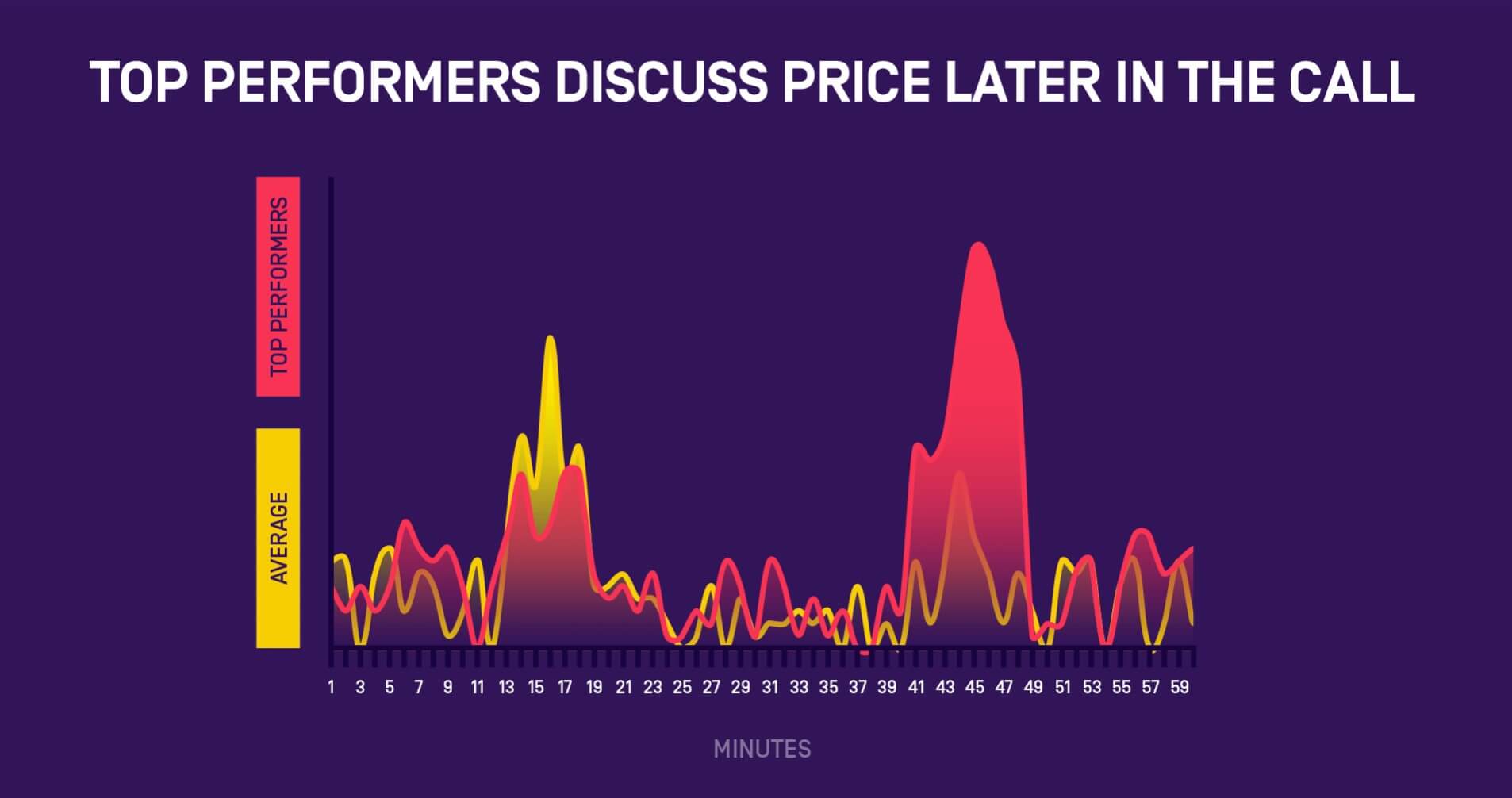
Once you build a relationship with your prospect and get them to see the value of your offer, you can ask budget questions like:
- What kind of budget can we expect to work with?
- How much do you currently spend on this problem?
- Have you tried other solutions? How much did they cost?
- What kind of ROI are you hoping to see?
These types of questions help you gauge how serious your prospect is about buying and whether they have the means to.
3. Identify key decision-makers
The second BANT criterion is authority.
Ideally, you want to work directly with decision-makers or, at the very least, someone who has a strong say in the final purchasing decision.
Decision-makers are often part of the C-suite or top-level management. They have the power to move deals forward. If a prospect doesn’t have the authority to approve purchases, your next priority is to identify and connect with a decision-maker.
Based on data from over 9,000 opportunities, we discovered that deals that didn’t involve a decision-maker were 80% less likely to close.
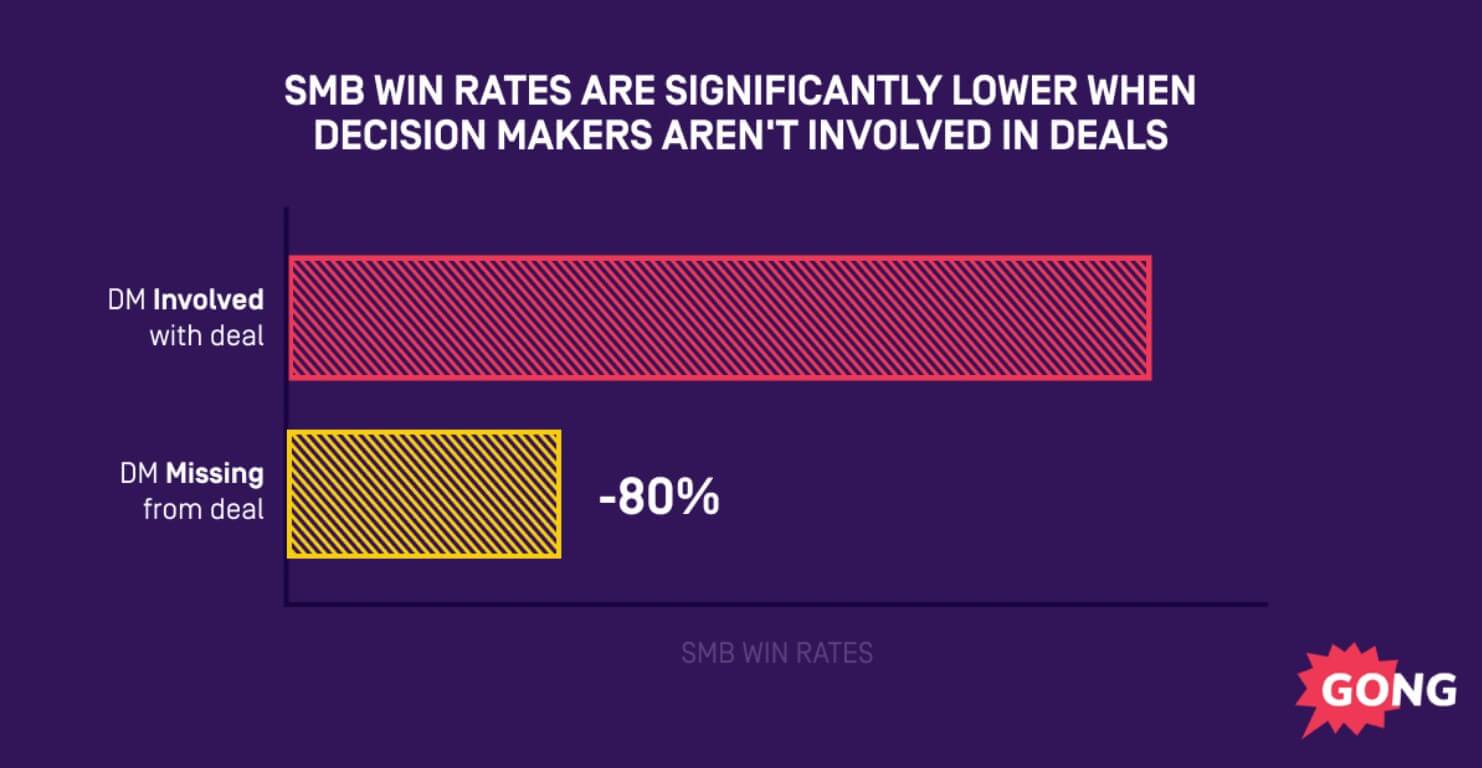
The difference was even more pronounced for enterprise deals with a sales cycle longer than 90 days and valued at over $100,000. These were 233% less likely to close when a decision-maker wasn’t involved.
Here are authority-based questions you can ask:
- Who will be using our solution?
- What steps are involved in approving a purchase like this?
- What was the decision-making process like last time?
- Do we need to invite anyone else to our next call?
Asking these questions can help you determine if a prospect is a decision-maker or if you need to get others involved.
4. Pinpoint your prospect’s pain points
The third BANT criterion is, need.
Learning your prospects’ needs will help you determine if they’re a good fit. It’ll also help you tailor your sales pitch and position your products or services as the solution.
For example, let’s say you offer an internal communication tool.
A rep learns that a prospect struggles with keeping their team on the same page. Important communications are often missed, affecting deadlines and resulting in unhappy customers.
If a rep determines that this prospect is a good fit, they can position their software as the solution by emphasizing how it can keep communications centralized and organized.
The key to uncovering your prospects’ pain points is to ask open-ended questions. The “sweet spot” for how many sales questions you should ask on a call is 11 to 14.
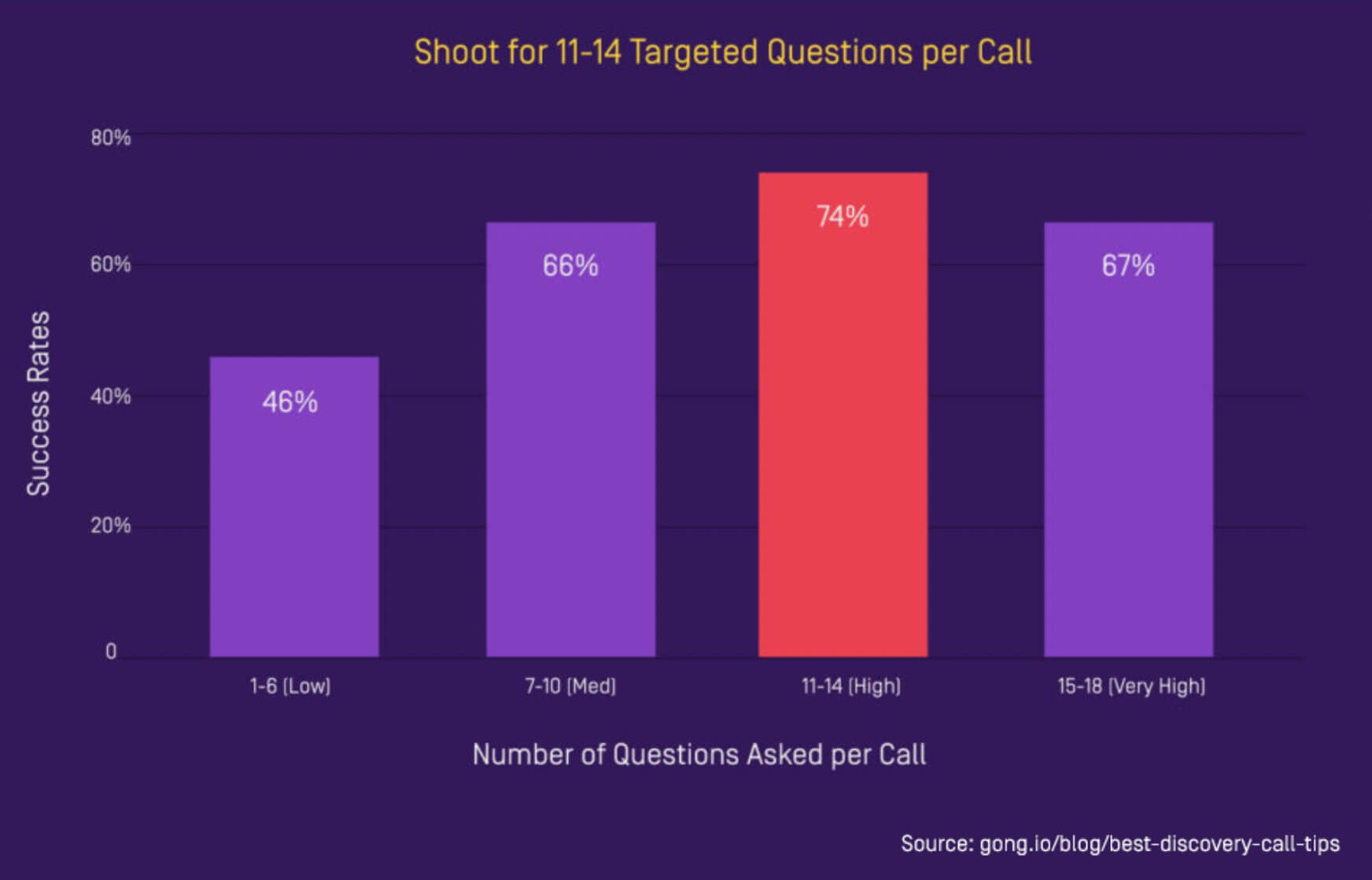
Asking too many questions can make it sound like an interrogation while asking too few can make it hard to unearth enough pain points.
Here are examples that you can ask to uncover pain points:
- What challenges are you currently facing?
- What steps have you taken to address this problem?
- How important is addressing this problem?
- What will happen if you don’t solve this problem?
Asking these questions will give you more information about your prospects and the extent of their problems. It’ll also help you determine if you can actually meet those expectations.
5. Know your prospect’s purchasing timeline
The fourth BANT criterion is the timeline.
Without a clear timeline, you run the risk of a long sales process. Knowing when your prospect plans to buy will help you manage expectations and plan your sales pipeline.
Before asking your prospects about their timeline, look at the average length of your sales cycle first. This will depend on factors like your industry, business model, and pricing.
For example, a product that costs $10 a month will have a faster sales cycle than a product that costs $1,000 a month. The latter will likely involve multiple stakeholders, which can extend the sales cycle by months or even longer.
As per HubSpot, the average sales cycle length for a SaaS product with an annual contract value (ACV) of $5,000 or less is 40 days. However, it increases to 170 days when the ACV is upwards of $100,000.
If a prospect has a purchasing timeline that falls at or below the average length of your sales cycle, they could be a great opportunity.
Ask these questions to get an idea of your prospect’s timeline:
- When are you looking to implement a solution?
- Does this purchase have any time constraints?
- Are there any upcoming events that you need this solution for?
- Do you have any contracts or commitments for a similar solution?
If a prospect has a purchasing timeline that exceeds your average sales cycle, you can either disqualify them or follow up at a later date.
6. Qualify your prospects and discuss the next steps
If you’ve followed the BANT framework up to this point, you should have everything you need to determine which prospects to push into your pipeline.
Maintain deal momentum by discussing “next steps” at the end of a call or meeting. Examples can include scheduling another call or setting up a sales demo. When prospects commit to an action, they’re more likely to follow through.
According to our data, win rates are significantly higher when reps discuss the next steps. It also leads to a shorter sales cycle.
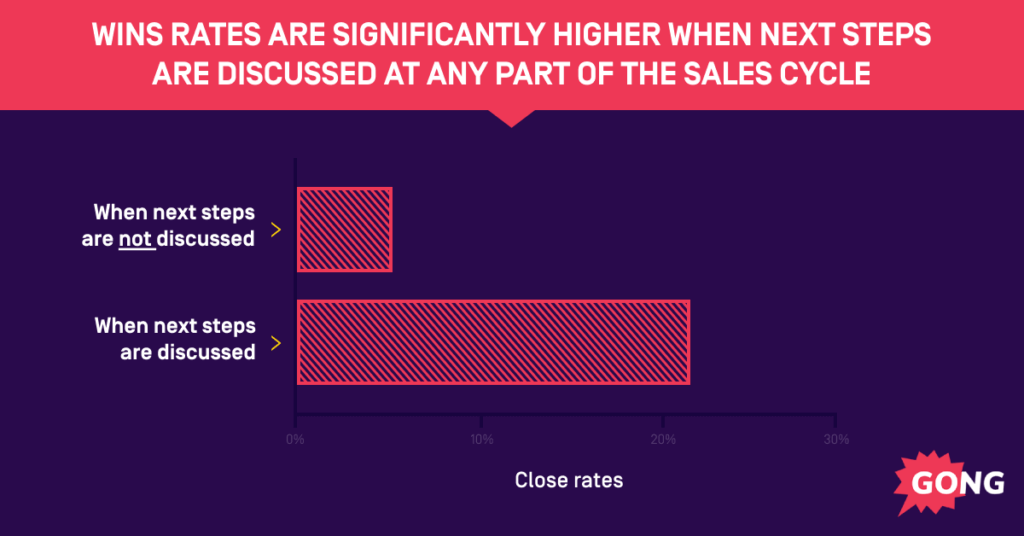
Spend time setting and confirming the next steps with your prospects. This will depend on where you are in their buying process. For example, if you’ve finished an introductory sales meeting, the next logical step is to set up a demo. At the end of a call, you might ask something like:
“I’m excited to show you how [feature] can help solve [pain point]. Would you like to go ahead and schedule a demo now?”
Always make sure to confirm the next steps to keep the deal moving. The last thing you want is to have a misunderstanding derail a potential deal.
BANT vs. MEDDIC: What’s the difference?
While BANT is one of the more well-established frameworks, it’s far from the only one. MEDDIC is another popular framework that sales teams use to qualify opportunities.
MEDDIC is an acronym that stands for:
- Metrics: Figure out the metrics or quantifiable goals that matter for your prospects.
- Economic buyer: Determine who has the authority to make decisions.
- Decision criteria: Learn what factors your prospects use to evaluate purchases.
- Decision process: Understand the steps that prospects follow to finalize a purchase.
- Identify pain: Uncover the pain points or challenges that your prospects are facing.
- Champion: Find someone who can act as an advocate for your company.
If you sell a product or service with a short sales cycle, the MEDDIC framework would be overkill. Prospects won’t have the patience to sit through the line of questioning required to learn their processes. BANT would be better in this case.
However, if you offer technical or complex products with longer sales cycles, consider implementing the MEDDIC framework. But make sure to get our 26 MEDDIC questions first and learn the exact questions you can ask to identify promising prospects.
Get our sales qualifying questions and boost your win rates
One of the biggest challenges that reps face is identifying the right prospects. Without properly qualifying them, the reps risk spending valuable time on prospects who are unlikely to convert.
So how do you ensure that your team is focusing on the right buyers?
By asking the right questions.
Click here to download our sales qualifying questions. You’ll get a list of qualification questions that cover the entire buying journey. It’s 100% free.
Ready for some BANTer?
To quickly recap, BANT involves qualifying prospects based on four criteria: Budget, Authority, Need, and Timeline. A prospect only needs to meet three of them to be considered validated.
Of course, once you qualify a prospect, your job isn’t over yet. You’ll need a way to manage your pipeline if you want to close more deals and to do that, you’ll need the right tools.
Request a demo to see how Gong’s sales software helps you gain complete visibility into your pipeline and unlock more revenue.